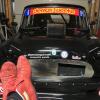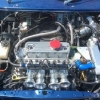Does any one know where I can find out what temperature the oil reaches on a full race Mini, as it is compressed before squirting out from the main-bearing caps ?
How Hot Does Oil Get ?
#1

Posted 17 December 2022 - 10:37 AM
#2

Posted 17 December 2022 - 10:49 AM
Can’t answer exactly but most oil thermostats open between 80-90 degrees C. And IIRC oil start braking down at 110-120 degrees C
#3

Posted 17 December 2022 - 12:21 PM
Does any one know where I can find out what temperature the oil reaches on a full race Mini, as it is compressed before squirting out from the main-bearing caps ?
Oil or, for that matter, any liquid is incompressible. That's why your brakes work.
As long as the oil is circulating freely, a temperature sender on the engine block will give a useful indication. Ideally, temperatures up to 130° C shouldn't pose problems. If it reaches 150° cool it down or damage will occur.
Attached Files
Edited by Quinlan minor, 17 December 2022 - 12:37 PM.
#4

Posted 17 December 2022 - 01:31 PM
Does any one know where I can find out what temperature the oil reaches on a full race Mini, as it is compressed before squirting out from the main-bearing caps ?
It's a question that's difficult to answer because there are too many variables and unknowns. What is the temp of the oil in the bottom of the gearbox (as apposed to the temp at the normal temp sender position)? What are the bearing tolerances? Is there an oil cooler fitted? If the car is stationary there is no air flowing past the gearbox fins to cool it. If you fit too big an oil cooler the oil would be relatively cool. You can vary the temp depending on all these factors.
#5

Posted 17 December 2022 - 01:58 PM
Interesting question,
As stated the oil isn't really compressible, it may expand as it gets hotter release dissolved gases or boil off emulsified water. The pressure is still a product of the elasticity of whatever is containing the oil - in practice the relief valve spring & expansion chamber in the gauge.
Engine bearings don't actually require pressure, they work on the principle of hydrodynamic lift: analogous to riding a rotating surf board.
The engine oil system's purpose is to supply oil at least as fast as it's lost from the bearings & provide a rate of flow that replaces it in the bearings before it gets "cooked". Oil pumps have a constant swept volume, so the output is proportional to the engine speed. leakage from the pump will reduce proportionally to the output & speed, but the leakage from the bearings will do the opposite as the centrifugal force increases with rpm.
I've no direct evidence, but suspect the majority of heat in the oil comes from the combustion cycle, same as for the cooling system - it's lubricating the cylinder wall (on the other side of the piston oil ring), before, during & after every power stoke.
#6

Posted 17 December 2022 - 04:37 PM
Interesting question,
As stated the oil isn't really compressible, it may expand as it gets hotter release dissolved gases or boil off emulsified water. The pressure is still a product of the elasticity of whatever is containing the oil - in practice the relief valve spring & expansion chamber in the gauge.
Engine bearings don't actually require pressure, they work on the principle of hydrodynamic lift: analogous to riding a rotating surf board.
The engine oil system's purpose is to supply oil at least as fast as it's lost from the bearings & provide a rate of flow that replaces it in the bearings before it gets "cooked". Oil pumps have a constant swept volume, so the output is proportional to the engine speed. leakage from the pump will reduce proportionally to the output & speed, but the leakage from the bearings will do the opposite as the centrifugal force increases with rpm.
I've no direct evidence, but suspect the majority of heat in the oil comes from the combustion cycle, same as for the cooling system - it's lubricating the cylinder wall (on the other side of the piston oil ring), before, during & after every power stoke.
Wow, that brought back flashbacks of studying the Stribeck curve model at uni 😆
#7

Posted 17 December 2022 - 05:34 PM
True, Oil isn't compressible but squeezing it while it's flowing sure does heat the hell out of it. Usually, the highest sport temps the Oil sees is in the Big Ends or under the Piston Crown. It's a difficult thing to measure, though, in engine development, it's one parameter that is measured, one way I know they used to do it was to use a crank that was fitter with thermocouples and a slip ring arrangement, these days, it might be done a different way though. Hardly practical for your purpose.
Perhaps one way to check if you are cooking the oil is after a session, have a Oil Analysis done to see if you are exceeding the oils upper withstand temp.
#8

Posted 17 December 2022 - 06:31 PM
Thank you all for your thoughts and opinions which generally accept that oil temperature is higher than water temperature.
While I agree that fluids aren't really compressible, the temperature of the oil in the outlet hose of a hydraulic pump, that is doing work, is higher than in the inlet hose.
This heat comes from the oil resisting being squeezed by what ever is driving the pump, and the pressure of the crank on the oil film in the bearing in the caps is similar, the caps being cooled by the copious flow of oil provided, hence the advantage of inserting an oil cooler between the pump and the main crank bearings.
I think that I need to explain.
I have an 5 bearing alluminium block, which, with a bit (lot) of adapting, will take a 998 Mini crank, BUT, one of the snags is that whereas the Mini main bearing is 30mm wide, the Alluminium block's mains are only 20mm.
I could risk running on 20mm mains, but with 3 not 5 main bearings, I'd feel happier with the whole 30mm width being supported.
Rather than the extra work, building up the webs and machining replacement steel caps, I'm thinking of doing both with a high quality Epoxy, but the Epoxy manufacturer tells me that their recommended formula depends on the heat to which it will be subjected; which is why I've asked my question.
#9

Posted 17 December 2022 - 11:01 PM
Hi Deadsquare
Thanks for the extra info. This seems to be a hard one to quantify.
I went and looked up what temp to blue a crank or bearings etc, but found no numbers just TOO HOT etc. BUT
Babbit - which is used in some shell type bearings and Lead - again in bearing shell composition can begin to melt at around 240 degrees C. This seems to gel with some general engine oil chatter - indicating destruction temps.
So for a glue - i would be looking for an operating range above 240 ,,,, but confirm this for yourself, Cheers
#10

Posted 18 December 2022 - 09:41 AM
Thanks Deadsquare, I wondered where you were going with this. Interesting project, hopefully you’ll keep us updated on its progress?
#11

Posted 18 December 2022 - 09:38 PM
Sounds immensely complex for sums to come up with anything more reliable than a suck it 'n see approach. I guess a simple comparison of bearing width would be fairly indicative - i.e. 3x30mm mains being 9/10ths of 5x20mm mains in load capacity (as far as the oil 'n white metal goes). What about crank flexion with narrower mains? It might actually be better at avoiding binding, but correspondingly nasty for vibration & fatigue.
Will the bearing shells sit centrally on the webs? Just 5mm over overhang would likely take some abuse and transfer it in to the block/caps - that could be the weak link if 3 have to do the work of 5.
Take it you're brewing something exotic to sit on a Mini transmission? Bolt on crank tail as an alternative???
#12

Posted 19 December 2022 - 12:58 PM
Sounds immensely complex for sums to come up with anything more reliable than a suck it 'n see approach. I guess a simple comparison of bearing width would be fairly indicative - i.e. 3x30mm mains being 9/10ths of 5x20mm mains in load capacity (as far as the oil 'n white metal goes). What about crank flexion with narrower mains? It might actually be better at avoiding binding, but correspondingly nasty for vibration & fatigue.
Will the bearing shells sit centrally on the webs? Just 5mm over overhang would likely take some abuse and transfer it in to the block/caps - that could be the weak link if 3 have to do the work of 5.
Take it you're brewing something exotic to sit on a Mini transmission? Bolt on crank tail as an alternative???
I have to get at least the centre web wider, to take the thrust washers.
Can a tail be bolted on without the block being shifted forewords and having a spacer between the block and the Transfer case ?
I have looked at friction welding a tail onto the crank.
MED do a 75mm throw, five bearing crank, which would be ideal, but it is probably £3,000.
Before lashing out, this would be a working mock-up that I'll test in my Mini Pick-up to see if it all hangs together.
Edited by DeadSquare, 19 December 2022 - 02:38 PM.
#13

Posted 19 December 2022 - 08:14 PM
Sounds immensely complex for sums to come up with anything more reliable than a suck it 'n see approach. I guess a simple comparison of bearing width would be fairly indicative - i.e. 3x30mm mains being 9/10ths of 5x20mm mains in load capacity (as far as the oil 'n white metal goes). What about crank flexion with narrower mains? It might actually be better at avoiding binding, but correspondingly nasty for vibration & fatigue.
Will the bearing shells sit centrally on the webs? Just 5mm over overhang would likely take some abuse and transfer it in to the block/caps - that could be the weak link if 3 have to do the work of 5.
Take it you're brewing something exotic to sit on a Mini transmission? Bolt on crank tail as an alternative???
I have to get at least the centre web wider, to take the thrust washers.
Can a tail be bolted on without the block being shifted forewords and having a spacer between the block and the Transfer case ?
I have looked at friction welding a tail onto the crank.
MED do a 75mm throw, five bearing crank, which would be ideal, but it is probably £3,000.
Before lashing out, this would be a working mock-up that I'll test in my Mini Pick-up to see if it all hangs together.
You have seen this haven’t you? https://www.amedm.co...uring-progress/
https://www.facebook...00051214636757/
#14

Posted 19 December 2022 - 08:23 PM
#15

Posted 19 December 2022 - 09:27 PM
I have to get at least the centre web wider, to take the thrust washers.
Can a tail be bolted on without the block being shifted forewords and having a spacer between the block and the Transfer case ?
I have looked at friction welding a tail onto the crank.
Before lashing out, this would be a working mock-up that I'll test in my Mini Pick-up to see if it all hangs together.
Yes, I was also thinking of the Ford conversion in the Vizard Book.
I'd be amazed if you could squeeze anything in to run the Mini primary/ transfer arrangement. But, bolting up the transfer case, sorting the oil pick-up etc could well make good use of some extra end space anyway. A taper has proved enough to give us a problem getting the flywheel off, so maybe one could contribute to keeping a crank & tail together
1 user(s) are reading this topic
0 members, 1 guests, 0 anonymous users





















